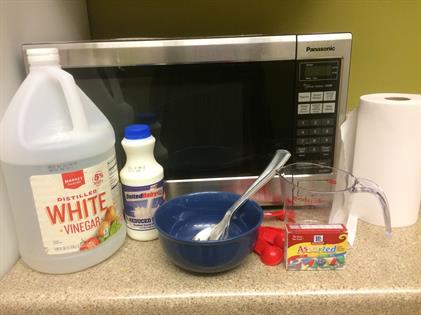Polymers: Making Plastic from Milk
Most kids have made slime with glue and borax.
Here’s how to use the science behind it to make plastic from milk!.
Fun Facts:
- Polymers are long strings of molecules. Imagine a chain. Each link is the same, and connected to a long line of other links. In a polymer, each link is the same kind of molecule or several molecules linked in a pattern.
- How a polymer behaves depends on the kind of molecules it has. Balloons and glue are both made of polymers, but are very different.
- Polymers can be natural or man-made. Wood, wool, silk, and even your hair and fingernails are natural polymers. Plastic, rubber and Teflon (non-stick coating on pans) are man-made.
- Milk contains a protein called casein, which is a natural polymer. It can be made into plastic that can be colored and shaped.
- Queen Mary of England had jewelry that was made of casein plastic!
Materials:
- 1 cup milk
- 4 teaspoons white vinegar
- Stove and pan or microwave and microwave-safe container
- Heat resistant bowl or mug
- Slotted spoon
- Paper towels
- Hard surface that is ok to get wet
- Cookie cutters, food coloring, glitter, markers (optional)
- Adult help for handling hot liquids
Directions:
- Heat the milk in a pan on the stove to steaming hot. If you prefer, you can heat the milk in the microwave at 50 percent for about 5 minutes. It should be about the same temperature as for hot chocolate. Heat a little longer, if necessary.
- Pour a ½ cup of water into the same bottle so that it now contains both liquids.
- Stir the milk and vinegar solution. What happens? Do more curds form? White vinegar is an acid. It made the casein in the milk unfold and reorganize into long chains.
- Put a stack of 4 paper towels on the hard surface.
- Use the slotted spoon to scoop the curds out of the bowl, letting the liquid drain. Put them on the paper towels.
- Fold the paper towels over and press more liquid out of the curds.
- Pick them up and knead them in your hands, like dough. This is casein plastic.
- Knead the casein plastic well. Add food coloring and glitter, if you like. Once the casein plastic is kneaded, you can shape it. Press it into a cookie cutter, or mold it into the shape you want (this takes more patience).
- Shaping needs to be done within about an hour of making the dough. After that, it will harden. If you want to hang it later (like Queen Mary’s jewelry), use a toothpick or other small, pointed object, to make a hole while the plastic is still pliable.
Extension:
- If you haven’t already, try making slime with white glue and borax. If you don’t have borax, try using liquid laundry soap or contact solution.
- Go on a polymer hunt! Look around your house. How many things can you find that are made of:
- Wood
- Plastic
- Rubber
- Paper
- Nylon, polyester, acrylic or rayon (hint: look at clothing tags)
Quick Links
Where are Activities Available?
We partner with over 600 educational organizations.
See our school locator